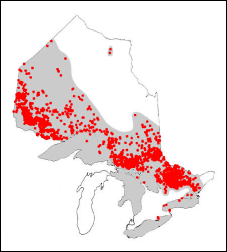Lake Trout
Information about the Lake Trout (Salvelinus namaycush), a cold-water fish native to Ontario.

Species image (Illustration Credit: U.S. Fish and Wildlife Service)
What it looks like
- green, grey, brown or almost black back, with lighter sides
- white belly
- light wormlike markings and spots on dark background, none are red
- white leading edge on lower fins, but no black line
- deeply forked tail
Size
- length: 30-80 centimetres (12-31 inches)
- weight: 1-5 kilograms (2-10 pounds)
- Ontario record: 28.6 kilograms (63.1 pounds)
Similar fish
Where it is found

Species distribution map (modified from Mandrak and Crossman, 1992)
Range
- Lake Ontario, Lake Huron, Lake Superior and across the deep, cold lakes of the Canadian Shield
- use Fish ON-Line, an interactive mapping tool, to find specific lakes and rivers
Habitat
- lakes at least 15 metres (50 feet) deep
Find a fishing spot with Fish ON-Line
Angling tips
- found near the surface just after ice goes out in spring, and deeper as the water warms up
- in early spring, some feed aggressively before dark
- in the summer, trout hit best in the morning when surface waters are calm
- use spinners, spoons and plugs with a fly rod, or as summer trolling baits
- use special deep-water tackle in summer – wire line, lead-core line, downriggers, diving planers
- try jigging, or still-fishing with large, dead minnows in deep water in summer
- ice fish with minnows, lake herring or jigs with spoons or bait attached
- take fish under 10 pounds with a medium-action spinning outfit with 8-pound test line
- trophy fish, common in northern waters, need stronger line
Common baits
- spoons, plugs, jigs
- large live minnows or dead bait
Updated: January 17, 2023
Published: July 18, 2014